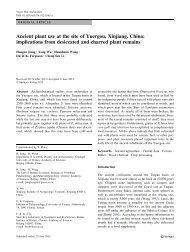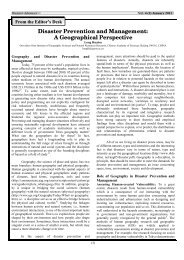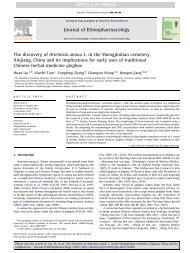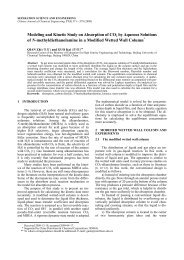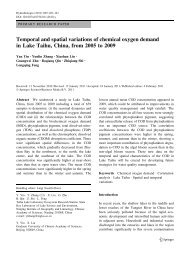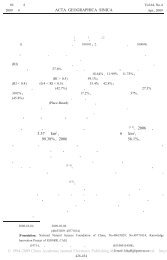THE 1920S DROUGHT RECORDED BY TREE RINGS AND ...
THE 1920S DROUGHT RECORDED BY TREE RINGS AND ...
THE 1920S DROUGHT RECORDED BY TREE RINGS AND ...
Create successful ePaper yourself
Turn your PDF publications into a flip-book with our unique Google optimized e-Paper software.
404 ERYUAN LIANG ET AL.and of these climatic proxies, trees growing in the arid or semi-arid regions canprovide annual or seasonal records of drought events through the study of theirannual rings (Fritts, 1976; Bradley and Jones, 1992; Schweingruber, 1996). Unlikethe general descriptions of drought disasters in historical records, high-resolutionprecipitation reconstructions using tree rings and other climatic proxies can providequantitative estimates of anomalous rainfall deficiency. In several case studies,tree-ring data has successfully reproduced the severe and sustained drought of the1660s and 1579–1598 in the Upper Colorado River Basin (Meko et al., 1995), themegadrought of the 16th century in North America (Stahle et al., 2000), the LostColony and Jamestown droughts in the southeastern USA (Stahle et al., 1998) andthe prolonged droughts in 1429–1519 and 1634–1741 in the northeastern TibetanPlateau (Shao et al., 2005). In addition, tree-ring networks can provide a pictureof temporal and spatial patterns of past drought events (Fritts, 1974; Hughes andGraumlich, 1996; Villalba and Veblen, 1997; Cook et al., 1999), enabling scientiststo learn more about the characteristics of droughts.China is subject to a strong monsoon climate with precipitation varying greatlyfrom year to year and from season to season (Zhang and Lin, 1992). In some years,rainfall is abundant enough to cause flooding, while in other years there is toolittle rain to support agriculture from region to region (http://www.mwr.gov.cn/english1/20040802/38161.asp). Thus affected by monsoons and topography, Chinais one of the countries with the most frequent drought and flood hazards in theworld (http://w.mwr.gov.cn/english1/20040802/38161.asp). According to the reportof damage in China (1949–1995), among all disasters, droughts lead to thegreatest economic loss (Damage Report, 1995). Based on the dryness/wetness indicesin eastern China over the last 530 years, studies found that the dry and wetanomalies initially appeared in northeastern China and then migrated to affectsouthern China (Hu and Feng, 2001; Qian and Zhu, 2001). The regional characteristicsof interannual and interdecadal variability are also outstanding. A quasi-20aand a quasi-70a oscillation exist in temperature and precipitation series in differentregions over China, but wet and dry spells occur in an opposite phase in the northand the south (Qian et al., 2003). The 1920s was the driest decade in northern Chinaof the past 120 years, and this dryness coincided with elevated temperatures (Xu,1997; Wang et al., 2004a).The identification of links between tree growth and documented drought eventsallows us to determine how accurately tree-ring records reflect drought occurrence.The 1920s drought was the most severe and well-recorded natural hazard in thelast 200 years in the semi-arid and arid areas of northern China (Xu, 1997). Avariety of historical records including newspapers, unpublished reports, and booksabout natural hazards in each province documented the 1920s drought and itssocial impact (Deng, 1937; Li et al., 1994). Based on the historical record, Li et al.(1994) considered the 1928–1930 drought to be one of the top ten natural disastersin modern Chinese history (1840–1949). Also recently, Xu (1997) analyzed thepossible social and natural factors leading to the great famine in the 1920s and early



